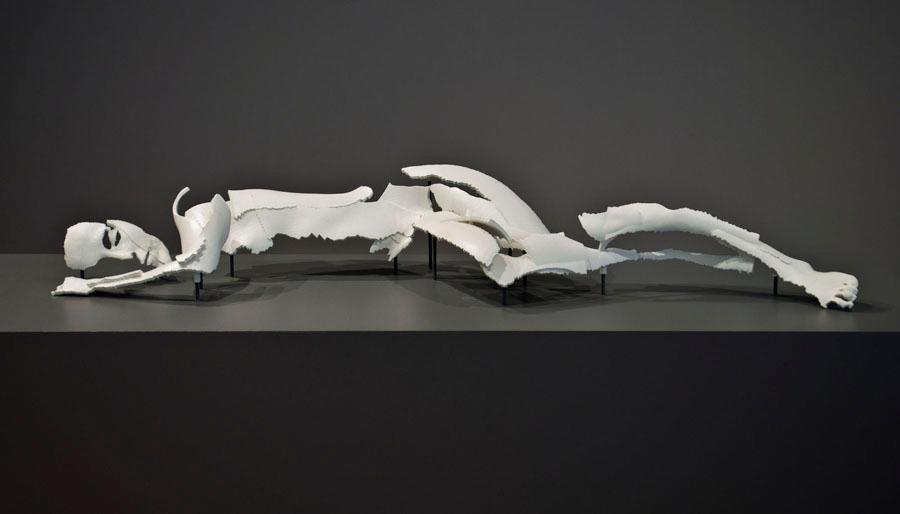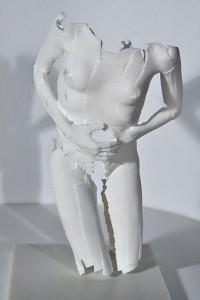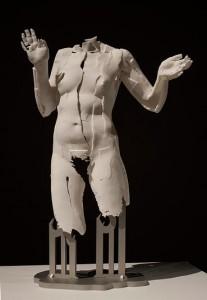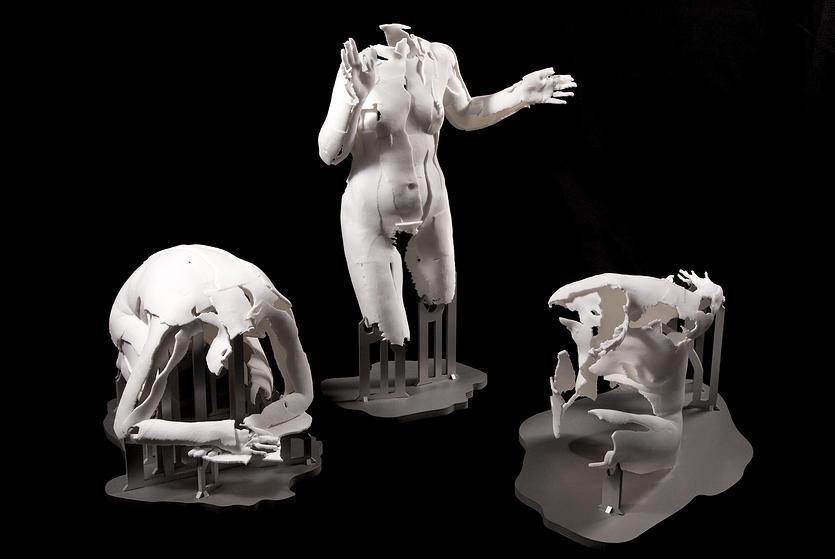In the mid-’90s I attended Philosophy graduate school when something called “deconstruction” was all the rage. In a nutshell, deconstruction criticizes a Western philosophical assumption that the natural and social worlds are objective and fully comprehensible through science. By contrast, deconstruction (and the related term “postmodern”) claims that scientific knowledge can’t represent all of natural and human life: knowledge is subjective and always partial or fragmented. Deconstruction suggests that complete representation of an object is impossible, and this sensibility has infused the Humanities and the art world. The term “deconstruct” eventually became a buzzword meaning to “overanalyze” or “take apart.” (As in, “OMG, they like totally deconstructed that movie.”)
However overused the term “deconstruction” is today, it remains a powerful backdrop to some of the more innovative artwork that rejects binary logic and tilts the dualistic deck toward concepts of subjective over objective, fragmentation over wholeness, flux over stillness, impermanency over permanency, fluidity over linearity, and lived over calculable time. Sophie Kahn’s 3D printed artwork is just such a concrete example of these more abstract and philosophical ideas, and she has her own aesthetic philosophy — gleaned from her confrontation with heavy issues like death and technology — that guides her overall project. Kahn’s artwork greets life by embracing its more repressed themes such as decay, madness, and death
Sophie Kahn’s 3D printed sculptures (along with her illustrations and videos) fit deconstructionist ideas, as she blurs lines between old/new media, digital/physical realms, and interior/exterior spaces. Haunting works that do not shy away from the deeply human issues of time, memory, history, identity, sanity, and the body, Kahn’s pieces are spectral fragments, haunting reminders of traumatic loss and fossil-like decay. Take, for example, her recent Période de délire, which illustrates a moment of madness as the body crouches into itself, away from a hostile world. But the body does not appear comforted, as it kneels on a seeming bed of nails.
Maybe it’s depressing, but Kahn’s figures are still here, in the world, and this gives Kahn’s work a hopeful tinge amidst the otherwise harsh and looming reality of aging and death. Her figures are not gone, only greatly — and perhaps only momentarily — compromised. Kahn’s creative process is well worth noting here as she blends “ancient and futuristic” techniques that are all embodied in “the resulting objects” that “bear the artifacts of all the digital processes they have been through.” She 3D scans bodies using a Polhemus hand-held laser scanner which never results in a perfect scan because it registers the smallest movements, such as when lungs breathe or eyes blink. Kahn described part of her technical process to 3Dprint.com:
“I start with a 3D laser scan, of my body or a model’s. I use a Polhemus handheld laser scanner, which I heavily ‘misuse’ to generate error and glitch. I work like a photographer, making a large number of scans and choosing only a few. I then edit those scans further, breaking them down and revealing negative space. For this I use Rhino, Maya, Netfabb, Mudbox and other programs. Lastly, I have to prepare the scan for 3d printing, making sure it is printable in my chosen material. I use Netfabb for this step. Recently I have been experimenting with generating supports to include in the final work, using Meshmixer and Photoshop… Each work takes several weeks for me to sculpt digitally because I can be obsessive about the form and details…”
Kahn takes the digital designs generated from “conflicting spatial coordinates” and then casts her sculptures from 3D printed molds. She explains:
“The smaller, cast metal pieces are made using a Dimension FDM printer (I like the build line detail when it’s cast in another material.) These were done at SAIC when I was in grad school. Otherwise I use the Shapeways EOS nylon printers.”
The mood of her work is initially somber, as it directly addresses impermanence and the impossibility of fixing (our bodies) in a moment of time. This isn’t morbid if you believe the truth of life’s finitude is more uplifting than the illusion of infinity. As Kahn explains about her sculptures:
“They also speak to the impossibility of ever capturing more than a trace of the past, or of a living, breathing body, despite our grandest efforts to fix it in place. This concern with the instability of memory and representation is the common thread that weaves together the ancient and futuristic aspects of my work.”
In a video from her website (also viewable below), Kahn explains how digitally scanned imperfections are really the poetics of technology’s failure to capture life. Kahn paraphrases novelist and critic Tom McCarthy’s argument that new technologies provide the dangerous illusion of frozen time, denying the inevitable passage toward illness, death, and decay. Kahn expounds:
“We work so hard to build these technologies as a hedge against death, to freeze life and to stop time. But what you end up building is your own tomb… I’m interested in exploring the ways that technology can fail to capture life and what the poetics of that failure might look like. We live in a world where we are so bombarded with claims for all-seeing, all powerful imaging technologies, and it’s my belief that as artists destabilizing those through poetics might be the strongest weapon that we have.”
The negative space captured in her artwork serves as a stark reminder that we entomb ourselves by our almost delusional use of social media: “…your hard drive filled with your photographs, your Facebook page filled with your status updates, your Instagram photos, those devices become our tombs.”
Because Kahn situates her work squarely within the critical framework of social media’s and digital scanning/photography’s failures, it’s worth noting that she knows photography intimately, and she produces stunning videos and video installations as well. Photography was her first chosen artistic medium as she worked her way from earning a BA from London’s Goldsmith College, to Melbourne, Australia’s RMIT University to study Spatial Information Architecture, finally receiving her MFA in Art & Technology Studies from the School of the Art Institute of Chicago in 2013. Kahn explained to 3Dprint.com her evolution from photography to 3D scanning and printing:
“I came to sculpture via a somewhat roundabout route. I trained as a photographer, but after graduating I became frustrated with what I thought of as the opacity of photography and the limitations of the material world I was photographing. I was drawn instead to 3d rendering, which allowed me to reimagine the spaces I was depicting (making buildings and bodies transparent, rendering the human body as though it were made of glass, etc). I enrolled in a course to learn 3d architectural rendering, and in the process I was introduced to 3d scanning and printing. It felt like a natural progression for me — a 3d scan is made from life, using (laser) light and a lens. But unlike a photograph, it can be rotated, revealing the blind spots between the things we see. A scan felt almost like a map of the incompleteness of human vision.”
When I asked Kahn about her artistic influences, she cited the great modern and body-focused sculpture of Louise Bourgeois and the self-portrait-based photography of Francesca Woodman. She also draws inspiration from other contemporary artists:
“I also love the work of artists who depict the body in extremis, like Berlinde de Bruyckere or Rachel Kneebone. I’m also inspired by the work of my mentors and peers working with 3D and the body from a contemporary and critical position. Last year I was included in the group show ‘New Romantics‘ at Eyebeam Center for Art & Technology in New York, alongside artists like Claudia Hart, Katie Torn, Ryan Whittier Hale and Tim Berresheim, which was a context I was really happy to be a part of.”
In this mass surveillance and digital tracking era, when corporations and governments reduce people’s value to algorithms and data sets, Kahn’s work reminds us that technological colonization is never absolute. There is always a trace or remainder of the living human outside our technological confinements. After all, if she thought technology’s rule over our lives was absolute — there would be no human figures to represent at all, would there?
Here I am reminded of the words of Martin Heidegger, philosopher and critic of modern technology: “…we shall never experience our relationship to the essence of technology so long as we merely conceive and push forward the technological, put up with it, or evade it. Everywhere we remain unfree and chained to technology, whether we passionately affirm or deny it. But we are delivered over to it in the worst possible way when we regard it as something neutral.”
Kahn’s own artistic philosophy is hardly neutral. She traverses the seemingly morbid registers of failure, decay, imperfection, partiality, incompleteness, and ultimately death itself. Her work is a confrontation that does not feel confrontative. It teases out a truth we know — unconsciously or consciously: we are all in process, unfixed and fluid entities moving toward an uncertain future from a past that defies full transparency. No amount of flashing cameras, uploading photos, and updating statuses can change this collective sealed fate. We are fortunate to have artists around producing works that remind us of this fact. In my humble opinion, Kahn is one of the best in this pursuit, and she credits 3D printing’s “democratization of materials in sculpture” with her ability to make the objects she envisions:
“3D printing has allowed me to make objects I could never have made in conventional ways, and to use materials I would otherwise have no way to access (living in New York City, I haven’t always had a studio, let alone access to a foundry or kiln). I think this democratization of materials in sculpture is a really big advantage of 3D printing.”
Kahn’s work has been widely exhibited in places like New York, Los Angeles, London, Paris, Tokyo, Osaka, and Seoul. To see some of her latest work, she collaborated with lead artist Claudia Hart on a video installation — OnSynchronics — for the “TechNoBody” exhibit is Pelham, NY that opened January 23rd. Her work will also be exhibited in the University of Pennsylvania, East Strasbourg exhibit, “5 in 3D: 3D Printing in Art and Design,” being held at the Madelon Powers Art Gallery from February 2 through March 6, 2015.
Let us know what you think about this type of artwork, and if you’ll see any exhibitions, over at the Sophie Kahn forum thread on 3DPB.com.
Subscribe to Our Email Newsletter
Stay up-to-date on all the latest news from the 3D printing industry and receive information and offers from third party vendors.
Print Services
Upload your 3D Models and get them printed quickly and efficiently.
You May Also Like
Consolidation in AM: How 2025 Is Shaping the Industry’s New Normal
The first half of 2025 has been marked by a clear shift in the additive manufacturing (AM) industry. Companies are no longer just focused on developing new tech by themselves....
Etsy Design Rule Change Reduces Selection of 3D Printed Goods
Online marketplace Etsy has implemented a rule change requiring all 3D printed goods on the site to be original designs. The update to the site’s Creativity Standards states, ¨Items produced using...
U.S. Congress Calls Out 3D Printing in Proposal for Commercial Reserve Manufacturing Network
Last week, the U.S. House of Representatives’ Appropriations Committee moved the FY 2026 defense bill forward to the House floor. Included in the legislation is a $131 million proposal for...
Transforming From Tourist to Native: Duro CEO Michael Corr Explains Why the Company Rebuilt its PLM Software on AI
In these early innings of the AI boom, many market analysts have expressed concern that AI spend has gotten too far ahead of the technology’s proven ability to deliver significant...






































